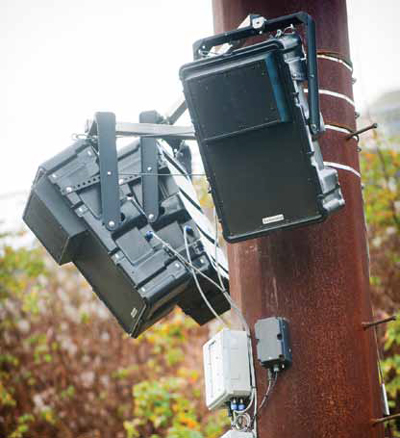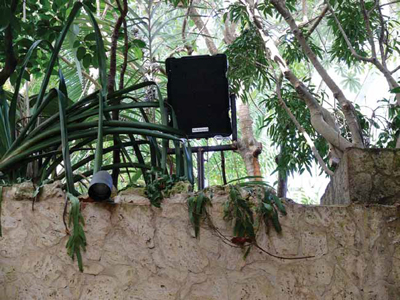The Community Professional Loudspeakers installation at the Duke Point Ferry Terminal at Nanaimo on Vancouver Island
has been facing the full force of coastal weather 365 days a year for 15 years. The cluster system, which utilizes Community’s M4 compression driver on five PC1542M
and three PC1564M long-throw, patterncontrol horns, was designed by MC Squared System Design Group and installed by Sound Source and Lightrix.AV is blowing up all over—literally. Every day, AV integrators are faced with scenarios subjecting their installations to the worst of what the world has to offer: weather, climate, voltage spikes, earthquakes, and theft, are just a few of the hazards that can instantly shut down AV systems.
As audio and video gear, and the equipment that powers and supports it, sees higher demand, there is a commensurate need for these systems’ vulnerabilities to be addressed. “AV products have evolved to require more protection,” confirmed Kevin Handerson, director of marketing for Middle Atlantic Products, a manufacturer of support and protection products for commercial AV. “They are more broadly deployed and used more often than ever before. People increasingly depend on AV for awareness and understanding of current events, their work, economic activity in general, and even emergency situations.
“In response, the foundational products Middle Atlantic provides have evolved greatly to provide improved protection for AV systems,” he continued. “For example, in the past we offered basic rackmount and vertical power distribution products—essentially, ‘power strips.’ Today, these products can be quite sophisticated, with built-in surge protection, thermal monitoring, metering, and over- and under-voltage protection.”
Technomad has been 100-percent focused on weatherproof/outdoor/waterproof loudspeakers and PA systems since its inception in 1995. Deployments for its gear range from the military to cruise ships, Olympic bobsled runs to theme parks, tropical resorts, and even inside of waterfalls. “Many projects come to us after ‘standard’ commercial solutions fail,” said Rodger von Kries, vice president of Technomad. “The usual reasons are extreme moisture, heat, cold, impact, vibration—or that other solutions don’t provide the needed intelligibility and audio quality in a rugged package.”

Technomad’s Berlin loudspeakers and PowerChiton amps enable designers to deliver multichannel audio to outdoor audio projects, with multi-decade lifespans.As von Kries highlighted, assuring longevity under extreme conditions is only half the battle—end-users today increasingly expect durability with no tradeoff in performance. “We find clients expect indoor PA system audio quality in outdoor venues,” he observed. “The days of settling for the sound quality of a typical 70-volt voice-range horn are over. Between full range systems like our Noho C loudspeaker and Berlin 15H loudspeaker for larger facilities, our new Oslo subwoofer— developed for a theme park customer originally—and the PowerChiton amps to drive the system, designers can deliver awesome multi-channel audio to outdoor audio projects, with multi-decade lifespans.”
But even the best-designed, highestfidelity speakers will quickly go silent if the electricity cuts out. Keeping the juice moving depends on equipment designed with tough conditions in mind, as Christos Desalernos, director of pro division sales for the AC power technologies specialists Furman, understands.
“Our products get thrown into a lot of interesting situations—Furman has been in use for a decade at the Burning Man festival, for example,” he said. “With the heat and the sand, it’s quite a hostile environment. But with Furman products like the P-3600 AR G global voltage regulator/power conditioner available, we’ve never had any failures there.”
As AV clients become increasingly reliant on online systems oversight, Desalernos noted that power management over IP solutions, such as Panamax/Furman’s BlueBOL T, provide integrators with an opportunity to step up their level of service. “Technology like BlueBOL T allows you to monitor, program, and control power units anywhere in the world over the internet. For instance, major South Atlantic theme parks have storm watchers, and if the danger of lightning gets to a certain threshold they unplug and shut down parts of the park. With power management over IP, a contractor can just unplug a device from their smart phone if they want to. While these capabilities have existed for years, the price point for achieving them has dropped significantly.”
As outdoor gear gets stronger, AV integrators and venues can look forward to other benefits, beyond the first-and-foremost safety considerations. “Extending service life is a really big deal,” pointed out David Fuller, director of technical marketing for QSC Audio, manufacturer of power amplifiers, loudspeakers, signal processing, digital signal transport, and computer control systems. “In a stadium, for instance, you need to bring in a cherry picker in order to service a loudspeaker. If you can increase the reliability and service life of that component using weatherization techniques, you may only need to bring in the cherry picker every three or four years—as opposed to every six months.”

The days of settling for the sound quality of a typical 70-volt voice-range horn are over, notes Technomad’s Rodger von Kries.Since humans have a habit of making things even more extreme, research and development in this space can be expected to press on. Fortunately the next big idea is always being formulated, as is often the case, by armed forces and ambitious entertainers alike.
“Military customers drove a lot of the original Technomad system designs, and you just can’t ask for better field-testing than what we did with the U.S. Armed Forces,” said von Kries. “Cruise ship lines challenged us to make our first rugged loudspeakers also salt-fog resistant and selfdraining, and our theme park customers have really surprised us with some of their requests! The request for underground subwoofers that can take being installed in drainage cisterns was an eye-opener.”
Speaking from the perspective of supporting AV systems, Handerson sees challenging conditions as the chance to deliver a wholly satisfying experience—one where system longevity, consistent performance, and serviceability are the actual wow factors.
“It’s no surprise, customers are more demanding than ever, even though they are asking for lower prices at the same time,” he said. “It might be easy to skip the protection to keep initial costs down, and hope for the best. But for many installers, the reasonable costs of current sophisticated protection products, including no extra cost for seismic certification, are well worth the initial expense. The reliability and life of the system, and the ability to support it, sets the stage for satisfied customers and repeat business.”
David Weiss (www.dwords.com) writes extensively about AV, audio, and broadcast technology.
Eight Tips for Protecting Equipment
1 Not all equipment needs the same level of security. When setting up a rack system you may want to consider adding a Dutch door. That way you can secure equipment in two separate areas within a single rack installation.
—Tim Wissman, Engineer, Lowell Manufacturing
2 Being energy efficient and ensuring longevity of the system (and the fans cooling it), aren’t mutually exclusive in the world of cooling. Thermal management capabilities have advanced to a level of sophistication enabling temperature sensing and automatic actions based on those readings. That means fans will be triggered to run when it gets too hot, and they will spin at varying speeds to bring the temperature under control, not just quickly, but efficiently too–drawing the minimal amount of energy necessary.
—Rebeca Villareale, Public Relations Manager, Middle Atlantic Products
3 Simple safety certifications do not tell the entire story. While many people think they are protected from devices bearing a certification from the Underwriter’s Laboratory or similar organizations, not all surge protection devices are tested and certified the same way.
—Marshall Currier, National Trainer, Panamax
4 Operational ergonomics is protection provided by supporting and formatting system gear in its optimum operational mode/position without regard to other placement factors, due to the protection offered by the desk/rack rolltop tambour door combinations. Gear that is easier to operate is less vulnerable to accidental damage, setups accidentally changed, or cables getting yanked out unceremoniously and at inopportune times.
—Richard R. Johnson, President, HSA
5 Beyond keeping your equipment organized, stable, and secure, the design is also a critical consideration. If your physical environment is disorganized and distracting, it will certainly affect how your clients feel, and how you feel about the result of your creative efforts. It is vital to protect the presentation of your workspace both to the outside world and to yourself.
—Nancy Greer, Senior Product Specialist, Argosy
6 AV furniture and racks are home to hundreds, thousands, even tens of thousands of dollars’ worth of equipment. Don’t forget about security. Items like security-bit rack screws, perforated steel security covers, locking doors and side panels prevent nimble fingers from accessing equipment.
-Rob Zurn, Lead Product Manager, Chief Rack Solutions
7 Understand where power issues are coming from. Many believe that the most common cause for power problems is due to lightning, and power problems can be solved by a “whole building” protection system. In fact, 80 percent of surges happen from within a building, and whole building systems are designed to protect the power coming into the building. Common occurrences such as HVAC compressors kicking on, generators, or even a refrigerator running can cause a surge within the building’s infrastructure, causing damage to any sensitive AV equipment.
-Shannon Townley, President, SurgeX
8 Too much static pressure and heat can rob a system of performance and eventually damage AV electronics. Your choices would be passive (no fans) or active (with fans) solutions. Remember to ask yourself these questions when you are designing your rack. What is the total temperature of my components and power? You should total the components (and power), and check that the room temperature can dissipate the heat of the rack efficiently. What components will you add—vented enclosure panels, vented top panel, or vented rear doors? Just make sure that the available flow of ambient air can effectively dissipate the heat in the rack.
—Kevin Groom, VP Sales and Marketing, IMS
